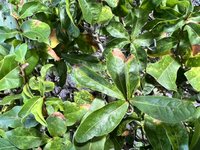IzzyG
Shohin
Hello all. I’m hoping someone could give some advice. Got this Laurel oak about 3 weeks ago from Florida and is now in Wisconsin. Been watering it once per day fully(until water drains the bottom holes) and giving it morning sun, afternoon shade(totaling 6 hours before it gets shaded by a larger tree above head). Wigert’s had fertilizer pellets on it so I’ve not been supplementing.
A week or so ago, some leaves started yellowing and some have even browned. I’m unsure if this is from acclimating(that’s Wigert’s guess) or something else. Soil feels ever so slightly damp every morning so it needs watering but not overly wet to skip. My two concerns are my hard water(tested pH is at 7.8) and the soil pH(test showed 7.9). I believe chlorosis can occur above pH 7 with them so I’ve supplemented with Miracid since I had some for my Azalea and also 1/2tsp of vinegar per watering can(brings pH down to 7 per testing). However, the leaves are not yellowing per chlorosis symptom(green veins, leave yellowing). Any ideas? Thanks in advance!
A week or so ago, some leaves started yellowing and some have even browned. I’m unsure if this is from acclimating(that’s Wigert’s guess) or something else. Soil feels ever so slightly damp every morning so it needs watering but not overly wet to skip. My two concerns are my hard water(tested pH is at 7.8) and the soil pH(test showed 7.9). I believe chlorosis can occur above pH 7 with them so I’ve supplemented with Miracid since I had some for my Azalea and also 1/2tsp of vinegar per watering can(brings pH down to 7 per testing). However, the leaves are not yellowing per chlorosis symptom(green veins, leave yellowing). Any ideas? Thanks in advance!






